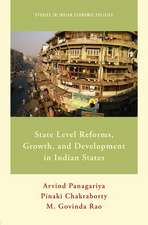Economic Modelling in the OECD Countries: International Studies in Economic Modelling
Editat de Homa Motamen-Scobieen Limba Engleză Paperback – 26 sep 2011
Preț: 415.29 lei
Nou
Puncte Express: 623
Preț estimativ în valută:
79.47€ • 82.47$ • 66.43£
79.47€ • 82.47$ • 66.43£
Carte tipărită la comandă
Livrare economică 17-31 martie
Preluare comenzi: 021 569.72.76
Specificații
ISBN-13: 9789401070393
ISBN-10: 9401070393
Pagini: 768
Ilustrații: 776 p.
Dimensiuni: 155 x 235 x 40 mm
Greutate: 1.06 kg
Ediția:Softcover reprint of the original 1st ed. 1988
Editura: SPRINGER NETHERLANDS
Colecția Springer
Seria International Studies in Economic Modelling
Locul publicării:Dordrecht, Netherlands
ISBN-10: 9401070393
Pagini: 768
Ilustrații: 776 p.
Dimensiuni: 155 x 235 x 40 mm
Greutate: 1.06 kg
Ediția:Softcover reprint of the original 1st ed. 1988
Editura: SPRINGER NETHERLANDS
Colecția Springer
Seria International Studies in Economic Modelling
Locul publicării:Dordrecht, Netherlands
Public țintă
ResearchCuprins
1 The LINK model and its use in international scenario analysis.- 2 Projections of the OECD economies in the global perspective, 1986—2000: policy simulations by the FUGI global macroeconomic model.- 3 Supply-side policies in four OECD countries.- 4 An empirical analysis of policy co-ordination in the United States, Japan and Europe.- 5 How much could the international co-ordination of economic policies achieve? An example from US-EEC policy-making.- 6 Capital risk and models of investment behaviour.- 7 Adjustment costs and mean-variance efficiency in UK financial markets.- 8 The macroeconomic and sectoral effects of the Economic Recovery Tax Act: some simulation results.- 9 Use of anticipations data in the anticipations model.- 10 An endogenously time-varying parameter (TVP) model of investment behaviour: theory and application to Belgian data.- 11 Budget consolidation, effective demand and employment.- 12 Interaction between economic growth and financial flows: presentation of a model analysing the impact of short-term financial disturbances on economic growth.- 13 Asymmetry in conservation: a capital stock analysis.- 14 Adjustment options for the US economy.- 15 Model building for decision aid in the agri-economic field.- 16 Estimated optimal lags for the optimization models: a method for estimating the optimal lag between economic variables.- 17 Macroeconomic policy and aggregate supply in the UK.- 18 Two recent trends combined in an econometric model for the Netherlands: the supply-side and sectoral approach.- 19 The supply-side of RIKMOD: short-run producer behaviour in a model of monopolistic competition.- 20 Direct interventions, interest rate shocks and monetary disturbances in the Canadian Foreign Exchange market: a simulation study.- 21 Effects of a fall inthe price of oil: the case of a small oil-exporting country.- 22 Modelling the effects of investment subsidies.- 23 Collective bargaining and macroeconomic performance: the case of West Germany.- 24 A cost—push model of galloping inflation: the case of Yugoslavia.- 25 Short-term forecasting of wages, employment and output in Barbados.- 26 Reducing working time for reducing unemployment? A macro-economic simulation study for the Belgian economy.- 27 An econometric model for the determination of banking system excess reserves.- 28 Forecasting versus policy analysis with the ORANI model.- 29 An applied general equilibrium model of the United States economy.- 30 A quarterly econometric model for the Spanish economy.- 31 Macroeconomic policies and adjustment in Yugoslavia: some counter-factual simulations.























